Name Clemenceau Builder Brest shipyard Commissioned 22 November 1961 Length 265 m Launched 21 December 1957 Beam 51 m | Namesake Georges Clemenceau Laid down November 1955 Decommissioned 1 October 1997 Construction started November 1955 Draft 8.6 m | |
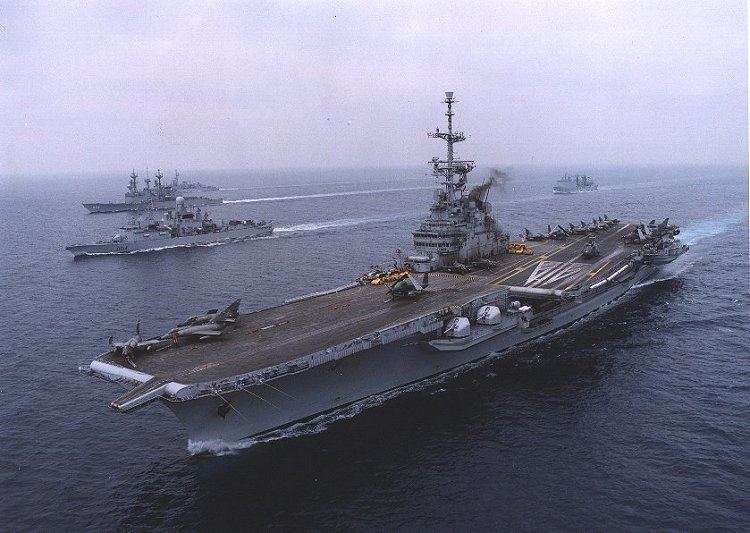 | ||
Clemenceau ([klemɑ̃so]), often affectionately called le Clem, was the French Navy's sixth aircraft carrier and the lead ship of her class. She served from 1961 to 1997, and was dismantled and recycled in 2009. She was the second French warship to be named after Georges Clemenceau, the first being a Richelieu-class battleship laid down in 1939 but never finished.
Contents
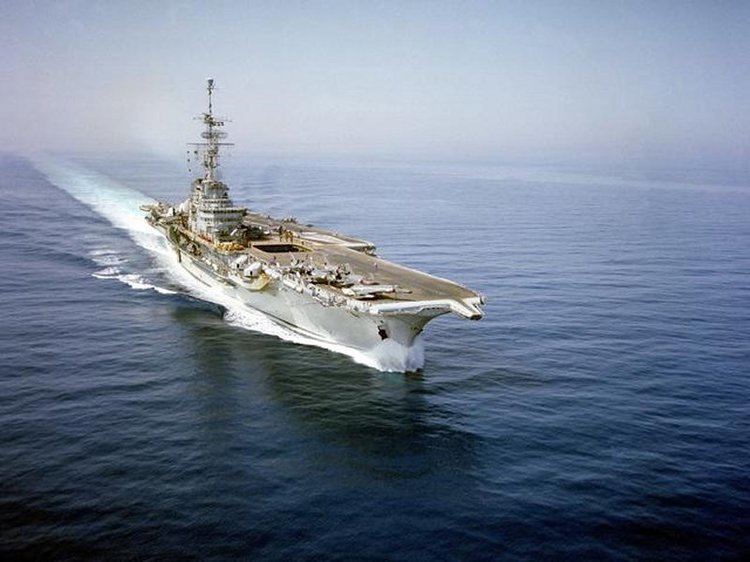
The Clemenceau-class aircraft carriers are of conventional CATOBAR design. The landing area is 165.5 m (543 ft) long by 29.5 m (97 ft) wide; it is angled at 8 degrees off of the ship's axis. The flight deck is 265 m (869 ft) long. The forward aircraft elevator is to starboard, and the rear elevator is positioned on the deck edge to save hangar space. The forward of two 52 m (171 ft) catapults is at the bow to port, the aft catapult is on the angled landing deck. The hangar deck dimensions are 152 m (499 ft) by 22 m (72 ft)-24 m (79 ft) with 7 m (23 ft) overhead.
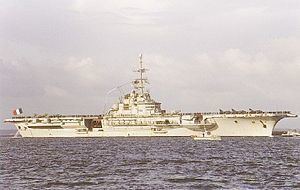
History
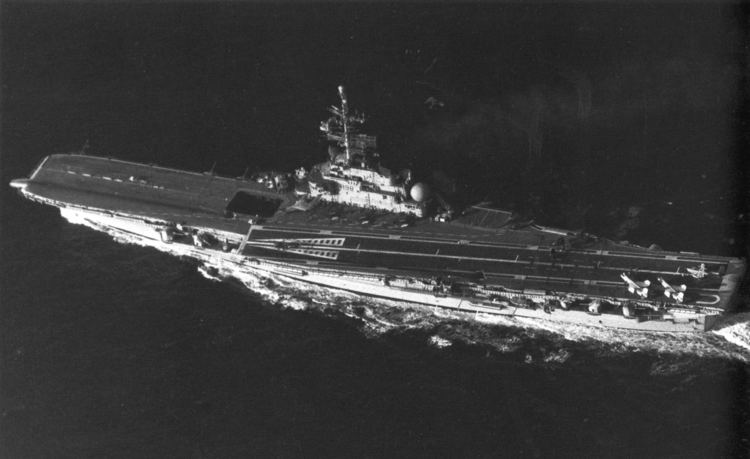
The development of Clemenceau represented France's effort to produce its own class of multi-role aircraft carriers to replace the American and British ships provided at the end of World War II. The ship was a small but effective design, using elements of United States carrier design, but to a smaller scale. The vessels were given relatively heavy gun armament for their size, and some stability problems were encountered which required bulging the hull.
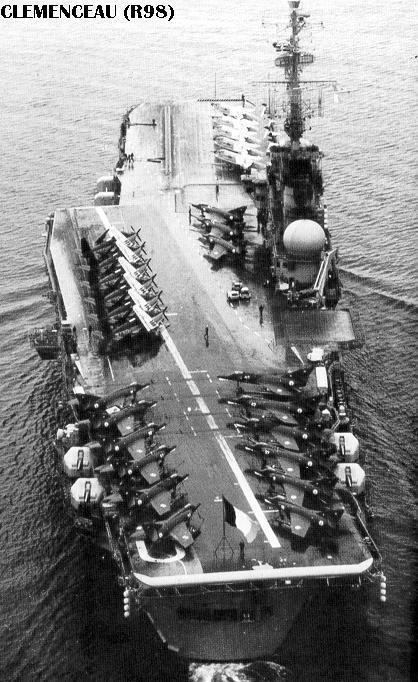
Clemenceau went through a major refit from September 1977 to November 1978. She was again refitted with new defensive systems from 1 September 1985 to 31 August 1987, including replacement of four of the 100 mm guns with a pair of Crotale surface-to-air missile launchers.
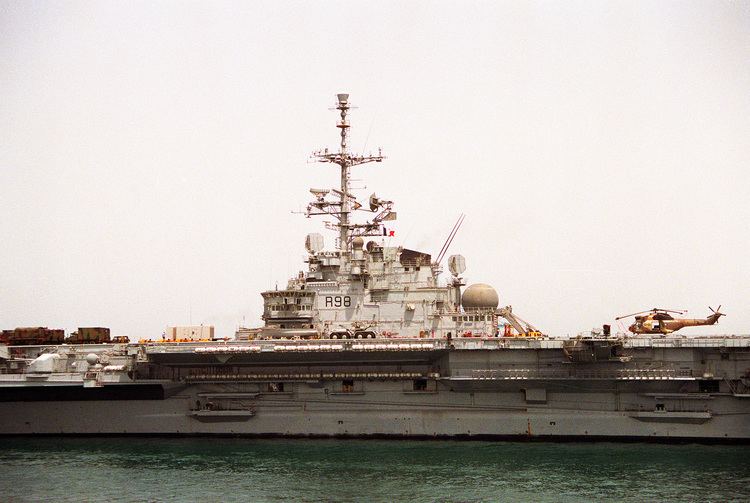
Clemenceau and her sister ship Foch served as the mainstays of the French fleet. During her career, Clemenceau sailed more than 1,000,000 nautical miles (1,900,000 km; 1,200,000 mi) in 3,125 days at sea, all over the world.
Missions
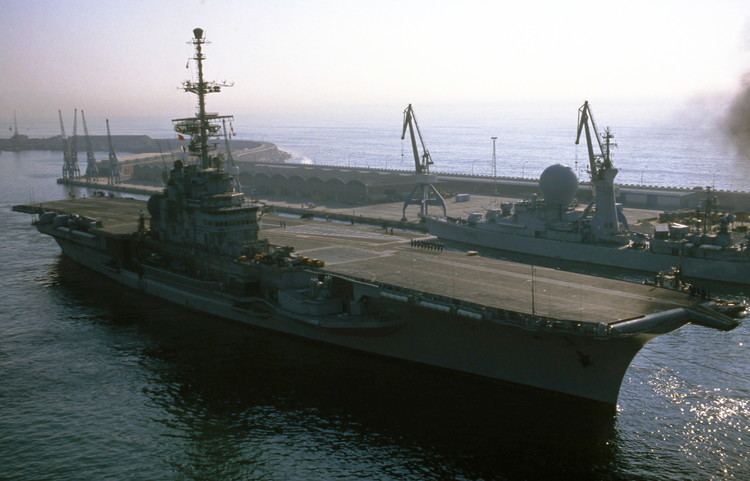
In 1968 (January) Clemenceau participated in the search for the lost submarine Minerve in the Mediterranean when contact was lost 25 nautical miles (46 km; 29 mi) from returning to port at Toulon. To this day no trace of Minerve has been found.
In 1968 the carrier deployed to the south Pacific for French nuclear bomb testing in Polynesia including Canopus, the first French hydrogen bomb. With the deployment of the fleet, codenamed Alfa Force, the naval force present around two atolls represented more than 40% of the tonnage of the entire French navy. Clemenceau was flagship of a fleet composed of forty ships which massed more than 120,000 tons displacement.
In 1974 during the Independence of Djibouti, Clemenceau deployed off the African coast in the Indian Ocean.
During the 1982–1984 Lebanese Civil War the aircraft carrier deployed in the east Mediterranean where she rotated with Foch, providing constant on-station air support to French peacekeepers.
In 1987–1988 Clemenceau participated in Operation Prométhée. The ship received orders to position in the Gulf of Oman and to protect French merchant traffic in the Persian Gulf from Iranian speedboats during Iran–Iraq War. She arrived in the area on 15 August 1987. An Iranian P-3 Orion was intercepted by F-8 Crusaders deployed from this ship on a Combat Air Patrol. The Promethee battle force (Task Force 623), included Clémenceau, the mine countermeasures support ship Loire, and Durance-class tankers Meuse,Var, and Marne.
In 1990, the ship, escorted by the cruiser Colbert and the tanker Var, transported 40 helicopters (SA-341F/ -342 Gazelles, SA-330 Pumas), three Br-1050 Alizés and trucks to Iraq during Operations 'Desert Shield & Desert Storm'.
Between 1993 and 1996 Clemenceau completed several tours including combat operations and air patrol over the former Yugoslavia during operation 'Balbuzard' to support the UN's troops.
Disposal
On 31 December 2005, Clemenceau left Toulon to be dismantled in Alang, India despite protests over improper disposal capabilities and facilities for the toxic wastes. On 6 January 2006 the Supreme Court of India temporarily denied access to Alang. After having been boarded by activists, held by Egyptian authorities, and then transiting the Suez Canal on 15 January, a court ruling by the Conseil d'État ordered Clemenceau to return to French waters. Able UK based at its Graythorp yard near Hartlepool received a new disassembly contract to use accepted practices in scrapping the ship. The dismantling started on 18 November 2009 and the break-up was completed by the end of 2010.
